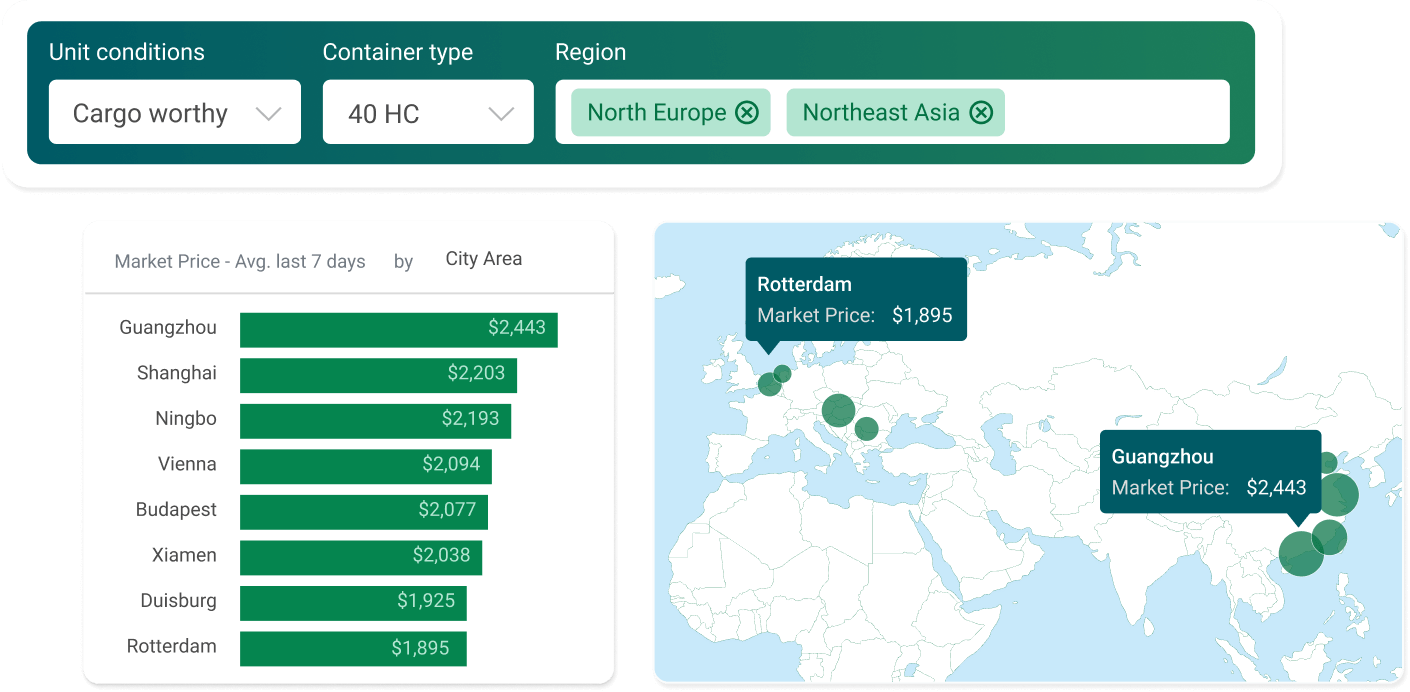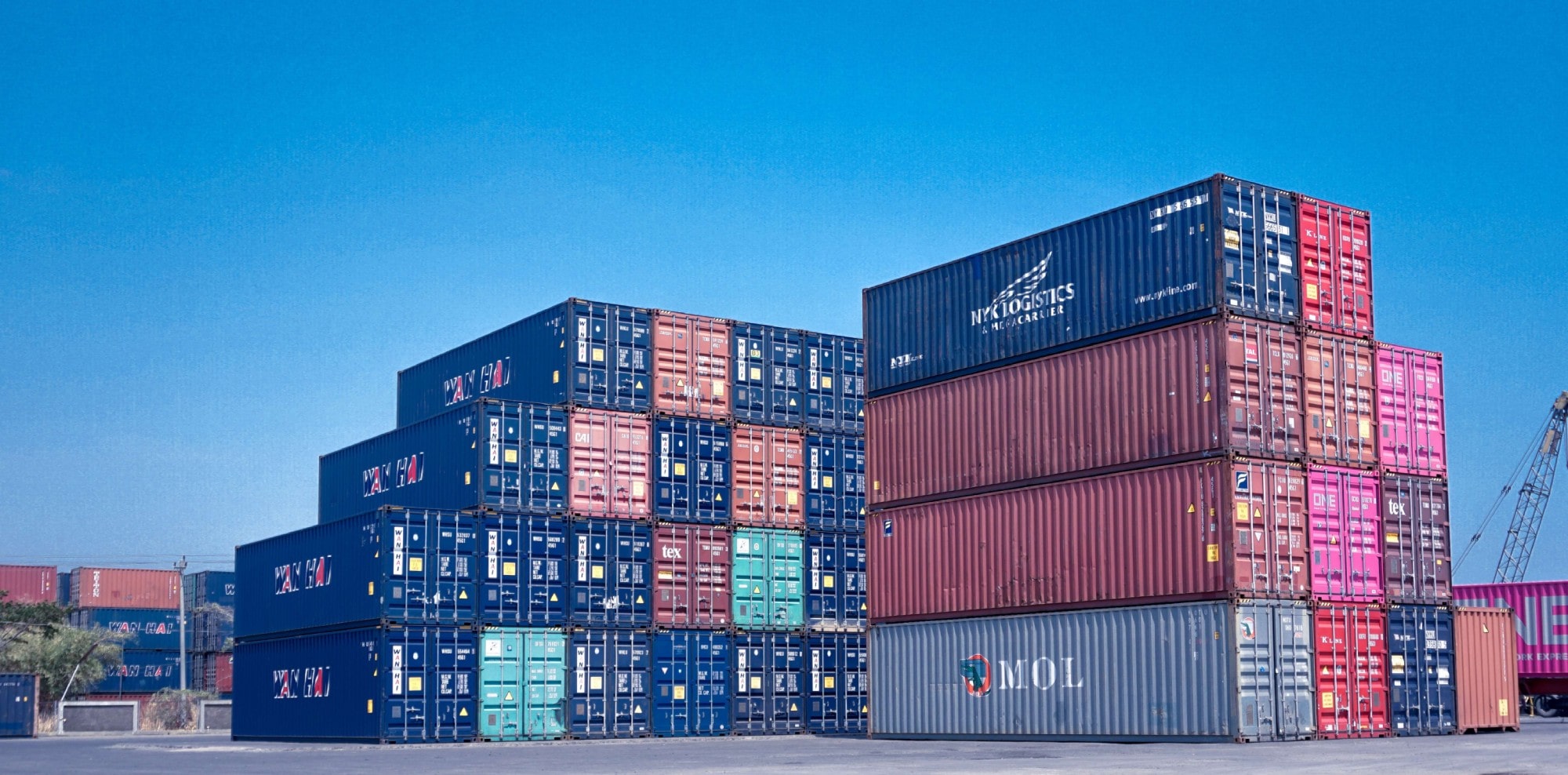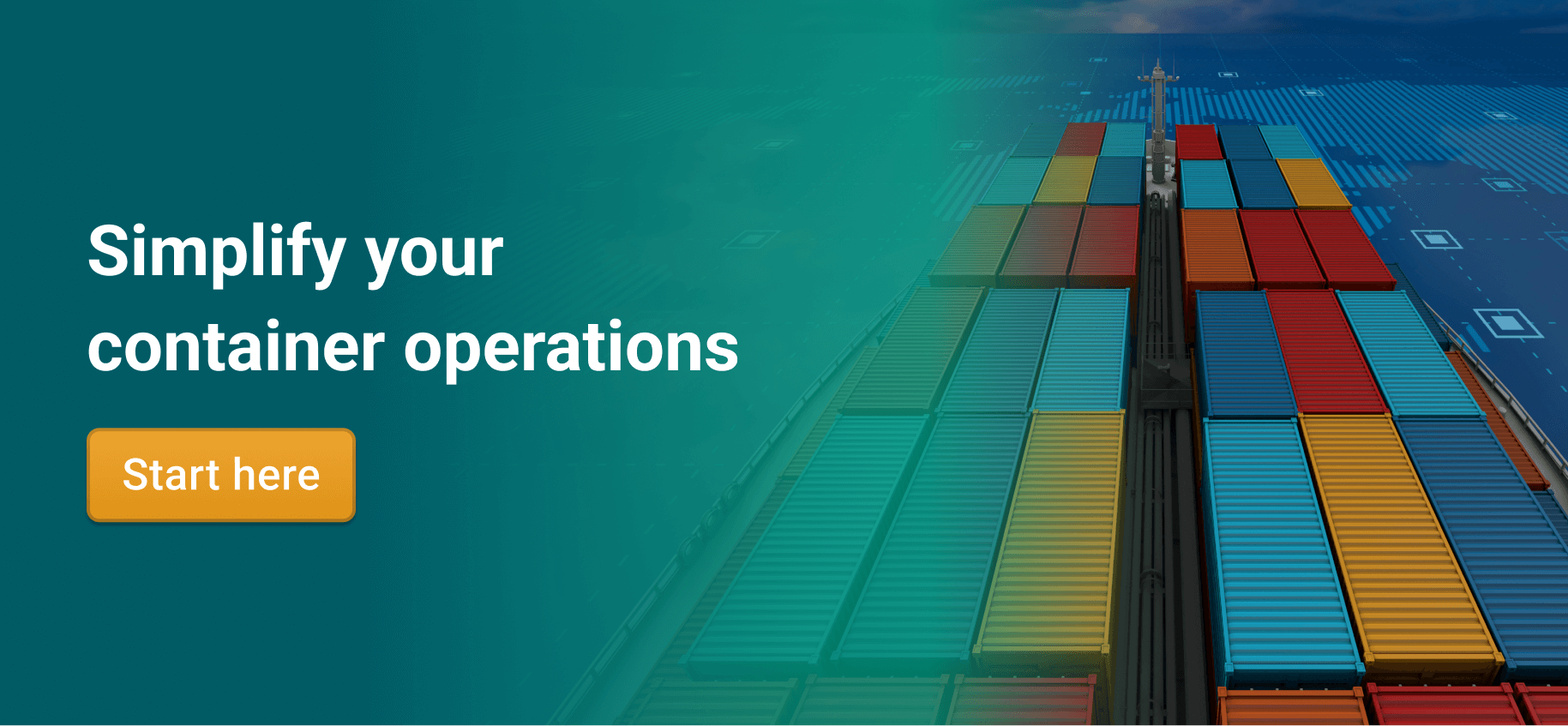The global shipping network is crucial in facilitating trade around the world. Currently, shipping vessels move around 90% of all goods between countries and cities. Learn more about this complex system, as well as how you can simplify your container operations with our all-in-one container logistics platform.
Even though the global shipping network is highly intricate, there are several ways you can streamline your container processes. We’ll learn more about these tools in this blog post. Want to skip the blog and get straight to our solutions? Schedule a quick call with one of our friendly experts to find out how Container xChange can completely transform the way you manage your equipment.
What is the global shipping network?

The global shipping network facilitates the flow of maritime traffic around the globe. It involves a complex system of ports and routes, accessed via oceans, canals and channels.
Today, this network links almost every coastal country in the world. Cargo is moved between the ports of these countries in containers aboard shipping vessels, owned primarily by shipping companies. Thus, ports act as nodes, while routes represent lines along this network.
Currently, the busiest sea route in the world exists between China and the US. The route is extremely unbalanced, with the cargo volume from China to the US being around 4 times as much as in the opposite direction. The English Channel is another extremely busy route, with at least 500 ships passing through this body of water each day.
So what makes the global shipping network so crucial to world trade? Let’s find out more now.
Importance of the global shipping network in world trade
Today, maritime connectivity is one of the most important drivers of global trade. As mentioned above, almost 90% of all goods and commodities move around the world via this intricate and complex network.
The network itself is made up of many ports and terminals, which act as links in the overall shipping process. Each link in the chain is crucial, and even the smallest break can have dramatic effects on trade as a whole.
It’s not only luxury goods like shoes, perfumes and jewelry that travel around the world on container ships, but most raw materials, food items and pharmaceuticals too. Without shipping, important materials for infrastructure, as well as medical supplies, and foods not indigenous to a region wouldn’t be accessible to other countries.
We saw this all too clearly during the Covid-19 pandemic, when, due to container shortages, pile ups and backlogs led to deficits of all kinds. This in turn resulted in layoffs in factories, business closures and massive price hikes for commodities.
Is there another way to transport cargo as cheaply and efficiently as via the global shipping network? The short answer is no. Just think of the sheer size of a shipping vessel, and how many millions of tons it can move around the world in one trip. There is no way any land or air vessel could match a shipping vessel, and there isn’t likely to be an alternative for some time to come.
Besides its importance in moving goods between countries, the global shipping network also provides millions of jobs worldwide. Currently, the population of seafarers working on international merchant ships is estimated to be around 1,892,720. That’s the population of a small country!
Role of ports in the global shipping network
Ports, as well as terminals, act as stations where goods are loaded, unloaded, transported inland, and vice versa.
They’re also a checkpoint where customs officials can make sure all goods passing into a country are legal, safe and meet the health and safety standards of the region.
Ports are huge spaces, which besides facilitating loading, unloading and intermodal transport, hold container yards for the temporary storage of shipping containers between journeys.
Now that we understand the importance of ports, let’s find out how transshipment ports work.
Also read: What is a container terminal? Types & top terminal operators [2023]
How transshipment ports connect global and local networks
First of all, what is transshipment? This is when a shipment of cargo is moved from one shipping vessel to another while in transit to its final destination. Transshipment is necessary when no direct connection exists between two ports.
A good example of transshipment would be between the ports of Durban in South Africa and Manila in the Philippines. Cargo going to Manila starts off its journey on one ship from South Africa to Singapore, where it is then reloaded onto another ship bound for Manila. The port in Singapore, therefore, acts as the transshipment port, connecting Durban and Manila ports together.
Transshipment ports are relatively inexpensive links between large ports around the world. They are also useful when a destination port is unavailable due to low tide, or a particular port can’t accommodate very large shipping vessels. In this case, the goods bound for that particular port are moved onto a smaller vessel at the transshipment port, before being taken to their destination port.
Let’s look at disruptions in the shipping network now.
Types of disruptions in the shipping network
As we mentioned earlier, the global shipping network is fragile. And certain types of disruptions can have dire consequences on worldwide trade. So what kinds of things cause such ripple effects?
Blockages or pile-ups
Remember when a shipping vessel got stuck in the Suez Canal for a week in 2021? This led to a pile-up of over 369 ships and prevented nearly $9.6 billion worth of trade. Once the canal reopened, the influx of delayed vessels then caused major congestion at ports, causing hold ups, as well as the late arrival of cargo.
Additional port controls and documentation
You’d be surprised just much an extra document or port check can delay the overall shipping process. During the recent Covid-19 pandemic, extra measures were put in place to keep staff safe and prevent the spread of the virus at ports and terminals around the world. These checks and balances added extra time to shipping processes and port activities.
Port closures
During the Covid-19 pandemic, many ports were temporarily closed in an attempt to keep Covid-19 at bay. This resulted in vessels being stranded at sea, unable to dock at ports or unload goods. It also meant that many goods were not able to be effectively shipped between countries, resulting in shortages and price hikes.
Talking about the Covid-19 pandemic, let’s take a closer look at how this affected the global shipping network overall.
Impact of COVID-19 pandemic on the global shipping network
The Covid-19 pandemic had devastating effects on the global shipping network, as well as on world trade as a whole. Such an event showed us just how fragile the supply chain really is, and has encouraged stakeholders to work to find ways to strengthen the system. Why? To preempt future disruptions and thus prevent them from collapsing the system.
In 2020, when the pandemic hit, we saw a sudden increase in demand for goods from Western economies, which led to a one-way flow of goods from China. At the same time, demand in the other direction remained low, and disrupted container traffic.
This resulted in a major container shortage, higher shipping costs, a demand for more storage space, and serious backlogs at terminals and ports around the world. Read all about how the Los Angeles port battled with container congestion and delays during this time.
Add to this port closures and restrictions, which seriously disrupted the flow of goods between countries. This resulted in goods shortages, price hikes and surplus issues, causing many businesses around the world to go bankrupt or close down.
Want to keep up-to-date with all of the latest news, container prices and market trends in the shipping world? We introduce to you our monthly ‘Where are all the Containers?’ report. Receive this insightful report right away by simply clicking below. Never miss a beat by downloading our report every month, and stay completely in the know.
How technology is transforming the shipping industry
In recent years, we’ve seen some exciting advances in logistics technology, promising to make the industry more efficient, cost-effective and safe. Read all about how the latest logistics technology is revolutionizing the industry here.
Let’s check out some of the most important advances in logistics technology now.
Blockchain
Basically, blockchain is a digital, public ledger that tracks transactions and asset movements. Each transaction is a ‘block’ in the overall chain. Blockchain has been instrumental in ensuring safer transactions and processes in the shipping world. With this digital technology, important processes like container tracking are done in real time, as data can be accessed from anywhere, anytime.
Robots and automation
Robotics and automation has been another game-changer in the logistics industry. Now, tasks that would have to be done slowly, carefully and manually by workers can be done automatically, or by robots.
Not only does this improve efficiency, but it also makes processes safer by removing human error, and taking workers out of dangerous environments. Robots are also extremely useful during labor shortages and help to cut costs.
Cloud logistics
Cloud logistics has done wonders for a highly complex industry such as the global shipping network. Data is stored in decentralized hubs and can be accessed from anywhere, by multiple players. This allows for more efficient information sharing, which in turn improves transparency, ultimately fostering more trust and reliability in the industry.
How to simplify complex ocean shipping with Container xChange
We know how fast the global shipping network is changing right now, as well as how complicated it can be to manage all of the moving parts. Especially if you have to switch platforms and contact sourcing channels multiple times a day for updates, prices and market trends.
We provide an all-in-one logistics solution. Let’s learn more about some of the features we offer on Container xChange below.
Source and trade shipping containers in 2,500+ locations
On our container marketplace, we have 10,000+ shipping containers available in various sizes, types and conditions. Whether you need a 20ft cargo-worthy container, or a one-trip reefer, you’re bound to find what you’re looking for in no time, at a price you’ll love. What’s more, our platform has equipment available in over 2,500 locations around the globe.
Get real-time shipping container prices
If calling sourcing channels regularly to get market prices eats up your valuable time, we’ve got the perfect solution for you.
With xChange Insights, you can access up-to-date prices in 180 locations around the world, any time you like. Prices are updated daily, so all you have to do is log in to stay informed.

Keep an eye on all of the latest container price trends, and see the cheapest locations to buy in. What’s more, keep your finger on the pulse when it comes to the most lucrative places to sell containers to make a profit.
Want a sneak peak of the Insights platform? Try it out for free today.
Book vessel space for your containers
Comparing vessel slot prices and accessing shipping schedules can be really time-consuming. Our Ocean Freight Marketplace is here to simplify things for you.
We’ve offer the first freight booking platform for shipper owned containers (SOCs). Now, instead of calling around to get slot prices and compare them, you can do it all in one place.
Check out some of the benefits below:

Use our OFM to find and compare vessel slots, access sailing schedules and check out the latest freight rates, with just a few clicks. Want to learn more? Learn all about the Ocean Freight Marketplace here.
Monitor real-time container journeys from pick-up to drop-off
Container tracking is important if you want to keep all stakeholders up-to-date on shipping delays and hold-ups. With Container xChange’s tracking tool, get a global view of your container fleet, and stay informed about ETAsWhat is estimated time of arrival? Estimated time of arrival, commonly known as ETA, is a frequently used term globally to denote the time of coming. In the shipping & logistics industry, it is ... More and hold ups, so that you can preempt issues and save on follow-up costs.
![]()
Track all of your equipment in one convenient place, and receive alerts as soon as a container requires your attention. At last, keep tabs on all of your shipping equipment on one easy-to-use dashboard.
Want to use our platform to trade containers, keep up-to-date with market prices, book vessel slots and track equipment efficiently? The next step is just a banner click away. Simply sign up for a free demo with one of our helpful experts, to learn more about how you can completely streamline your container operations with Container xChange.
What does ‘global shipping’ mean?
Global shipping means the worldwide network of shipping traffic. This involves the movement of container ships laden with cargo between ports around the globe. Currently, around 90% of all cargo is transported via the shipping vessels.
What does port connectivity mean?
Port connectivity refers to how well various ports around the world are connected to one another in the global shipping network. This includes how accessible a port is for regular ocean liners, as well as cargo ships.





